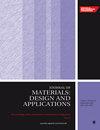探索带有三维打印功能分级芯材的曲面夹层板的弯曲行为
IF 2.2
4区 材料科学
Q3 MATERIALS SCIENCE, MULTIDISCIPLINARY
Proceedings of the Institution of Mechanical Engineers, Part L: Journal of Materials: Design and Applications
Pub Date : 2024-03-27
DOI:10.1177/14644207241241211
引用次数: 0
摘要
三明治结构因其在各行各业,尤其是航空航天领域的高强度重量比而备受关注。要满足应用需求,就必须优化机械性能,如弯曲刚度、峰值载荷、比吸收能量和重量。本研究提出了一种独特的方法,涉及具有功能分级芯材的曲面夹层板的设计和制造技术,旨在实现全面的弯曲性能。曲面结构的应用领域广泛,包括起落架。夹芯板的半圆形夹芯由三个不同的区域组成,分别由 Ф、Υ 和 90-Ф- Υ 角度定义。这些角度规定了不同蜂窝状单元的位置和比例,包括高密度、中密度和低密度单元。这些角度及其细胞类型的任何变化都会产生新的密度梯度。制造出的夹层结构由熔融沉积模型打印机打印的聚乳酸芯组成,夹在铝皮之间。三个模型的实验测试和有限元分析结果表明两者非常吻合,最大误差为 14.45%。模拟得到验证后,又扩展到其他配置。随后,利用从模拟步骤中提取的结果对基于上述角度的数学模型进行了校准。在此过程中,各种结构的刚度(从 0.29 到 0.79 kN/mm)、峰值载荷(从 1.73 到 4.77 kN)和比吸收能量值(从 41.78 到 96.09 J/kg)都得到了改善。所提出的方法有望用于这些结构的工程设计及其多目标优化。本文章由计算机程序翻译,如有差异,请以英文原文为准。
Exploring bending behavior of curved sandwich panels with three-dimensional printed, functionally graded cores
Sandwich structures have garnered significant attention due to their high strength-to-weight ratio in various industries, particularly aerospace. Meeting application demands requires optimizing mechanical properties such as bending stiffness, peak load, specific absorbed energy, and weight. This study presents a unique approach involving the design and manufacturing techniques of curved sandwich panels with functionally graded cores, aiming to achieve a comprehensive spectrum of bending properties. Curved structures have applications across diverse fields, including landing gear. The semi-circular core of the sandwich panel comprised three distinct regions defined by angles: Ф, Υ, and 90-Ф- Υ. These angles specified both the location and proportion of different honeycomb cells, including high, medium, and low-density cells. Any variations in these angles and their cell types resulted in a new density gradient. The manufactured sandwich structures consisted of polylactic acid cores printed by a fused deposition modeling printer, sandwiched between aluminum skins. Experimental tests and finite element analysis for three models showed strong agreement, with a maximum error of 14.45%. After the simulation was validated, it expanded to cover other configurations. Subsequently, mathematical models based on the aforementioned angles were calibrated using results extracted from the simulation step. This process led to achieving various structures characterized by a wide range of stiffness (ranging from 0.29 to 0.79 kN/mm), peak load (ranging from 1.73 to 4.77 kN), and specific absorbed energy values (ranging from 41.78 to 96.09 J/kg). The proposed methodology exhibits promise in engineering the design of these structures and their multi-objective optimization.
求助全文
通过发布文献求助,成功后即可免费获取论文全文。
去求助
来源期刊

CiteScore
4.70
自引率
8.30%
发文量
166
审稿时长
3 months
期刊介绍:
The Journal of Materials: Design and Applications covers the usage and design of materials for application in an engineering context. The materials covered include metals, ceramics, and composites, as well as engineering polymers.
"The Journal of Materials Design and Applications is dedicated to publishing papers of the highest quality, in a timely fashion, covering a variety of important areas in materials technology. The Journal''s publishers have a wealth of publishing expertise and ensure that authors are given exemplary service. Every attention is given to publishing the papers as quickly as possible. The Journal has an excellent international reputation, with a corresponding international Editorial Board from a large number of different materials areas and disciplines advising the Editor." Professor Bill Banks - University of Strathclyde, UK
This journal is a member of the Committee on Publication Ethics (COPE).
 求助内容:
求助内容: 应助结果提醒方式:
应助结果提醒方式:


